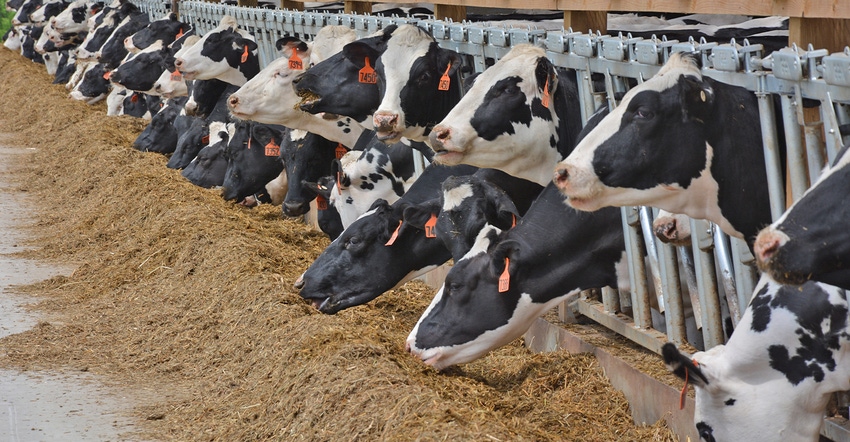May 7, 2019

As Minnesota’s dairy industry faces one of its toughest economic challenges in decades, the Minnesota Milk Producers Association is asking the state Legislature to adopt three proposals this session to help state dairy farm families.
According to Lucas Sjostrom, MMPA executive director, the proposals are:
1. A state dairy margin insurance rebate that would provide dollars to dairy farmers enrolled in the federal coverage program.
2. Tax relief by adopting a conformity provision to the new federal tax law when farmers sell through cooperatives.
3. Conservation payments to eligible dairy farms that adopt conservation and sustainability practices.
“Minnesota has long prided itself as one of the top dairy-producing states in the country,” Sjostrom said in a statement. “Dairy is one of the most significant value-added sectors in Minnesota agriculture since so much of the processing needs to occur close to the farms where milk is produced.”
MMPA recently surveyed its membership and learned the current economic conditions of Minnesota dairy family farmers are as bad, if not worse, than what most experts have assumed.
The survey showed:
Poor economic conditions. 97% describe “current economic conditions facing dairy farmers in Minnesota” as “poor;” 3% said “fair; 0% responded as excellent or good.
Dairy farmers in crisis mode. 91% strongly agreed with the statement that “Minnesota dairy farmers are in a crisis, experiencing some of the worst economic conditions in years;” 5% somewhat agreed with the statement; 5% disagreed.
Credit is tightening. When asked to describe their “current situation with lenders when it comes to securing operating loans for your dairy farm,” 40% say they either can’t get financing or that the terms are unreasonable. Here’s the breakdown:
• 15% need credit but lenders won’t extend any new loans
• 25% can get financing, but the terms are unreasonable
• 45% said financing is tighter than in the past, but the terms are manageable
• 9% said they don’t need or plan to seek new financing this year
Need legislative support. 79% said it is very important that “the Minnesota Legislature authorize support (Example: $0.20 to $0.30 per cwt) to help dairy farmers bridge through the current economic conditions; 14% said it is somewhat important; and 5% said it is not important.
“Since legislators have to weigh competing priorities each year, we felt there was an urgency to get current information directly from dairy farmers to help legislators appreciate the magnitude of the dire situation facing Minnesota farm families,” Sjostrom said. “While we were hoping for better news, we hope Minnesota legislators and all Minnesotans will agree that dairy is experiencing unique challenges that justify a unique response with support for our farm families yet this session.”
The four-question survey was emailed to MMPA members. Responses were submitted between April 5 and April 24. Depending on the question, the response rate was 19% to 26%.
May 17 webinar on DMC and DRP
A webinar will be hosted by I-29 Moo University at noon on May 17 to review the 2018 Farm Bill’s Dairy Revenue Protection program and the Dairy Margin Coverage program.
DMC is a voluntary risk management program that offers financial protection to dairy producers when the difference between the all-milk price and the average feed cost (the margin) falls below a certain dollar amount selected by the producer.
Sign up for the program opens on June 17.
Presenters will include Marin Bozic, University of Minnesota, and Josh Newton and Cassandra Monger, Compeer Financial.
Bozic will outline developments in the Dairy Revenue Protection program and how producers are benefitting from it as well as forecasts for the next year.
Newton is a crop insurance team leader and Monger is a dairy industry specialist, both with Compeer Financial. They will focus on Dairy RP from a lender’s perspective, including results from the first quarter of 2019; how Dairy RP can be individualized for each farm; executing the program from application to endorsement; and how the program fits into a producers overall risk management plan.
Registration is not required for the webinar.
To access the webinar, go to z.umn.edu/RPwebinar.
For more information, contact Jim Salfer at 320-203-6093 or [email protected]; or contact Fred Hall at 712-737-4230 or [email protected].
New online tool
USDA recently announced the availability of a new web-based too, developed in partnership with the University of Wisconsin, to help dairy producers evaluate various scenarios using different coverage levels through the DMC program.
The University of Wisconsin launched the decision support tool in cooperation with FSA and funded through a cooperative agreement with the USDA Office of the Chief Economist. The tool was designed to help producers determine the level of coverage under a variety of conditions that will provide them with the strongest financial safety net. It allows farmers to simplify their coverage level selection by combining operation data and other key variables to calculate coverage needs based on price projections.
The decision tool assists producers with calculating total premiums costs and administrative fees associated with participation in DMC. It also forecasts payments that will be made during the coverage year.
For more information and to access the online tool, go to fsa.usda.gov/dmc-tool.
For DMC sign up, eligibility and related program information, visit fsa.usda.gov or contact your local USDA Service Center. To locate your local FSA office, visit farmers.gov/service-locator.
Sources: MMPA, U-M Extension, USDA, which are solely responsible for the information provided and are wholly owned by the sources. Informa Business Media and all its subsidiaries are not responsible for any of the content contained in this information asset.
You May Also Like




